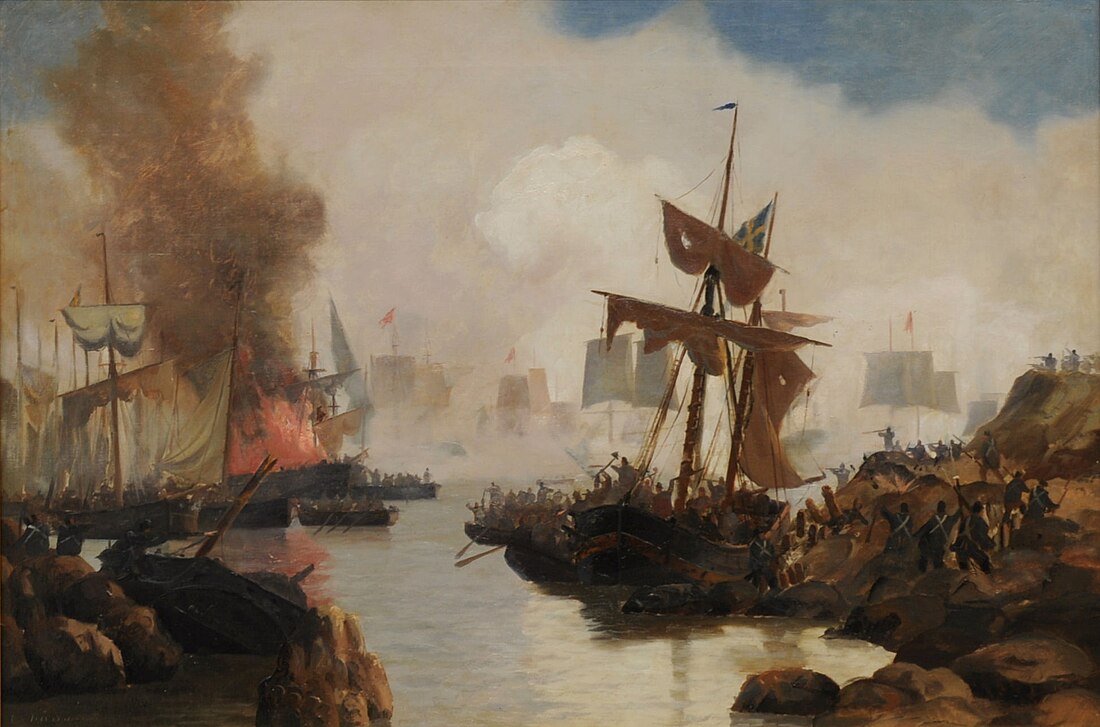Top Qs
Timeline
Chat
Perspective
Battle of Dynekilen
1716 naval battle of the Great Northern War From Wikipedia, the free encyclopedia
Remove ads
The naval Battle of Dynekilen (Danish: Slaget ved Dynekilen) took place on 8 July 1716 during the Great Northern War between a Dano-Norwegian fleet under Peter Tordenskjold and a Swedish fleet under Olof Strömstierna. The battle resulted in a Dano-Norwegian victory.
This article includes a list of references, related reading, or external links, but its sources remain unclear because it lacks inline citations. (September 2014) |
You can help expand this article with text translated from the corresponding article in Danish. (June 2023) Click [show] for important translation instructions.
|
Remove ads
Background
On 28 October 1709 Frederik IV of Denmark, the Danish-Norwegian king declared war against Sweden. The war declaration came after the Swedish defeat at the Battle of Poltava, which resulted in a decisive victory for Peter I of Russia over Charles XII of Sweden.
In the naval enactment, a light Danish-Norwegian force of seven ships under Peter Tordenskjold trapped and defeated a Swedish transport fleet of 44 ships in Dynekilen fjord, just north of Strömstad, on the west coast of Sweden. The Swedish transport fleet was transporting troops, ammunition and supplies from Gothenburg, destined for the land forces under the command of Charles XII invading Norway.[7]
Remove ads
Battle
Summarize
Perspective
The Danish-Norwegian flotilla ambushed the Swedish fleet while it was positioned in the harbour of Dynekilen. In the process, it overcame and destroyed a small island fort equipped with six 12-pounder guns positioned in the harbour entrance. The largest Swedish ship, Stenbock, a former ship of the line converted into a cannon barge, surrendered, after which the lighter vessels were run aground, and an attempt made to destroy most of them. The Dano-Norwegian forces worked to put out fires and salvage as many of the ships as possible. They managed to save and capture 30 ships, while 14 ships, consisting of various galleys and transport ships, were successfully destroyed by the Swedish. Swedish land forces continued to fire muskets from the surrounding hills during these operations, eventually forcing Tordenskjold to leave, but not preventing him from taking with him all of 30 captured Swedish ships. The Dano-Norwegian force suffered 76 casualties, 19 killed and 57 wounded.
On account of the loss of this transport fleet at Dynekilen, Charles XII was forced to abandon the invasion of Norway and withdraw his troops to Sweden, where he was soon preoccupied with setting up defences against the expected combined Danish and Russian invasion force.
Remove ads
Ships involved
Denmark-Norway (Tordenskjold)
- Hjælper 47 (barge)
- Hvide Ørn 30 (frigate)
- Vindhund 16 (frigate)
- Charlotte Amalia 7 (galley)
- Louisa 7 (galley)
- Prinds Christian 7 (galley)
Sweden
- Stenbock 24 (barge) - Surrendered
- Proserpina 5 (galley) - Captured
- Ulysses 5 (galley) - Captured
- Lucretia 12 (galley) - Captured
- Wreden 21 (galley) - Sunk, later salvaged by the Swedes.
- Achilles 5 (half-galley) - Captured
- Pollux 5 (half-galley) - Captured
- Hector 5 (half-galley) - destroyed.
- Castor 5 (half-galley) - Sunk, later salvaged by the Swedes
- Biorn 4 (double-sloop) - Captured
- Svarte Maeren 4 (double-sloop) - Captured
- Schelpaden 12 (Gallioth) - Sunk, later salvaged by the Swedes
- Transports - 5 captured, 3 destroyed
All according to Tordenskjold's own report.[8]
Notes
Sources
Wikiwand - on
Seamless Wikipedia browsing. On steroids.
Remove ads

